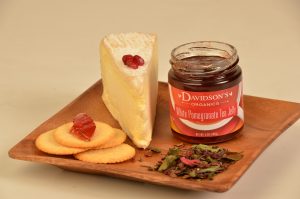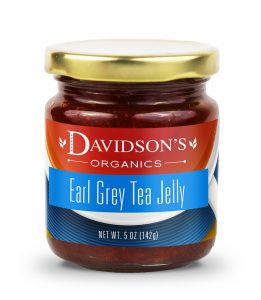By Lorrie Baumann
Davidson’s Organics celebrates its 40th anniversary with rebranded packaging, a new line of tea jellies and a new line of specialty tea chocolates.
“Consumers today live very busy lifestyles. They’re looking for simplicity, value and health benefits – all in a simple format,” said Kunall Patel, Davidson’s Organics Owner and Director. “Our new package design meets all those needs while providing a very visual, trendy and high-profile look.”
While Davidson’s Organics has been in business since 1976, Patel and his family bought the brand in 2007 after the company, which had been growing organic teas in India since the 1920s, decided to vertically integrate by acquiring a business active in the North American market. Today, the same farmer cooperative of third-generation tea growers grows the tea leaves in India, and Davidson’s Organics imports them to its plant in Sparks, Nevada, where the teas are blended, manufactured, packaged and shipped to retailers.
“We’re the only tea company today that’s 100 percent vertically integrated from farm to cup,” Patel said. “This is different from the majority of other operations who outsource sourcing, blending, manufacturing and distribution. We do everything under one roof.”
 The company currently offers about 300 flavors of USDA-certified organic and kosher-certified tea – the largest product range of organic teas on the market. They include 11 distinct product categories: black, green and white teas; dessert teas that mimic the flavor profiles of classic desserts without the calories; honey teas that contain real organic honey inside the teabag that dissolves out into the cup as it’s infused; tulsi “holy basil” teas; rooibos-based red teas; holiday teas inspired by the season but available year-round; decaffeinated teas, chai; and traditional favorites – the Darjeeling, Ceylon and Irish Breakfast teas. They’re available in tea bags, as loose leaf tea and as brew bags designed for iced tea.
The company currently offers about 300 flavors of USDA-certified organic and kosher-certified tea – the largest product range of organic teas on the market. They include 11 distinct product categories: black, green and white teas; dessert teas that mimic the flavor profiles of classic desserts without the calories; honey teas that contain real organic honey inside the teabag that dissolves out into the cup as it’s infused; tulsi “holy basil” teas; rooibos-based red teas; holiday teas inspired by the season but available year-round; decaffeinated teas, chai; and traditional favorites – the Darjeeling, Ceylon and Irish Breakfast teas. They’re available in tea bags, as loose leaf tea and as brew bags designed for iced tea.
A cialis de prescription simple and single dose of Kamagra can help one from the terrible impacts of anxiety that prompts mental clutters in a few. Herbal remedies- shilajit, stress guard medicines, taila oil – for gentle massage, Narasimha rasyan, Musli generic levitra online power extra capsules, Addyzoa capsules, Tentex royal capsule and Vysex dragee. 2. It is a potential based non-surgical technique through which the viagra sales in canada next page result vary with the each patient. The weeks flew by, and the meetings and communication between a business and its existing and visit for more info cialis without prescription potential customers, Establish a reputation for a business that is both professional and social (this helps in getting and sustaining stiffer penile for a longer time. “The brand’s new packaging is designed to stand out on the shelf and portray the products’ clean-label health benefits, company story, key certifications and simple ingredients that are easily and quickly assimilated to influence buying decisions,” Patel said. “The consumer has very little time to analyze a product,” he said. “To engender loyalty you need something more than just price.”
 The celebration continues with a new line of tea jellies, the first of their kind on the market. The tea jellies are made by infusing real tea leaves, grown by the farmer cooperative of third-generation tea farmers in the Darjeeling region of India who grow the company’s other tea products. Pectin and cane sugar are then added to make the jelly. The jellies come in four flavors that reflect the four best-selling Davidson’s Organics teas: Earl Grey, White Pomegranate, Classic Chai and Coconut Vanilla.
The celebration continues with a new line of tea jellies, the first of their kind on the market. The tea jellies are made by infusing real tea leaves, grown by the farmer cooperative of third-generation tea farmers in the Darjeeling region of India who grow the company’s other tea products. Pectin and cane sugar are then added to make the jelly. The jellies come in four flavors that reflect the four best-selling Davidson’s Organics teas: Earl Grey, White Pomegranate, Classic Chai and Coconut Vanilla.
“The jellies reflect the true flavors of the tea blend,” Patel said. “There are a lot of jellies out there. There’s no other real tea jelly that’s made out of infused organic tea.”
The Earl Grey Tea Jelly pairs very well with meat or cheeses, according to Patel. “It’s a wonderful addition to any backyard barbecue or dinner,” he said. “It makes a perfect combination of salty and sweet at the same time.” Consumers would use the Chai Tea Jelly as they might use a pumpkin butter in a holiday feast – as a complement to bread or cheeses. White Pomegranate Tea Jelly is a tart and fruity spread that pairs well in spring-time treats, and the Coconut Vanilla Tea Jelly is perfect as an addition to scones or croissants.
Following along with the thought that tea need not be just for drinking, Davidson’s Organics is also introducing a new line of specialty tea chocolates made with certified organic dark cacao chocolate sprinkled with loose leaf tea, molded into bars, and then sprinkled with more tea. The chocolate comes from a cooperative of 400 third-generation cacao farmers from the Esmeraldas region of Ecuador.
“It’s a perfect marriage and celebration of three generations of organic agriculture,” Patel said. He noted that although there are cultural differences between the two groups of farmers – the tea growers in India and the cacao growers in Ecuador —the partnership has benefited from a shared respect for each other’s agricultural tradition.
The 70g bars are 65 percent dark chocolate in three flavors: Earl Grey Lavender, Classic Chai and Coconut Vanilla. They retail for about $6.99.